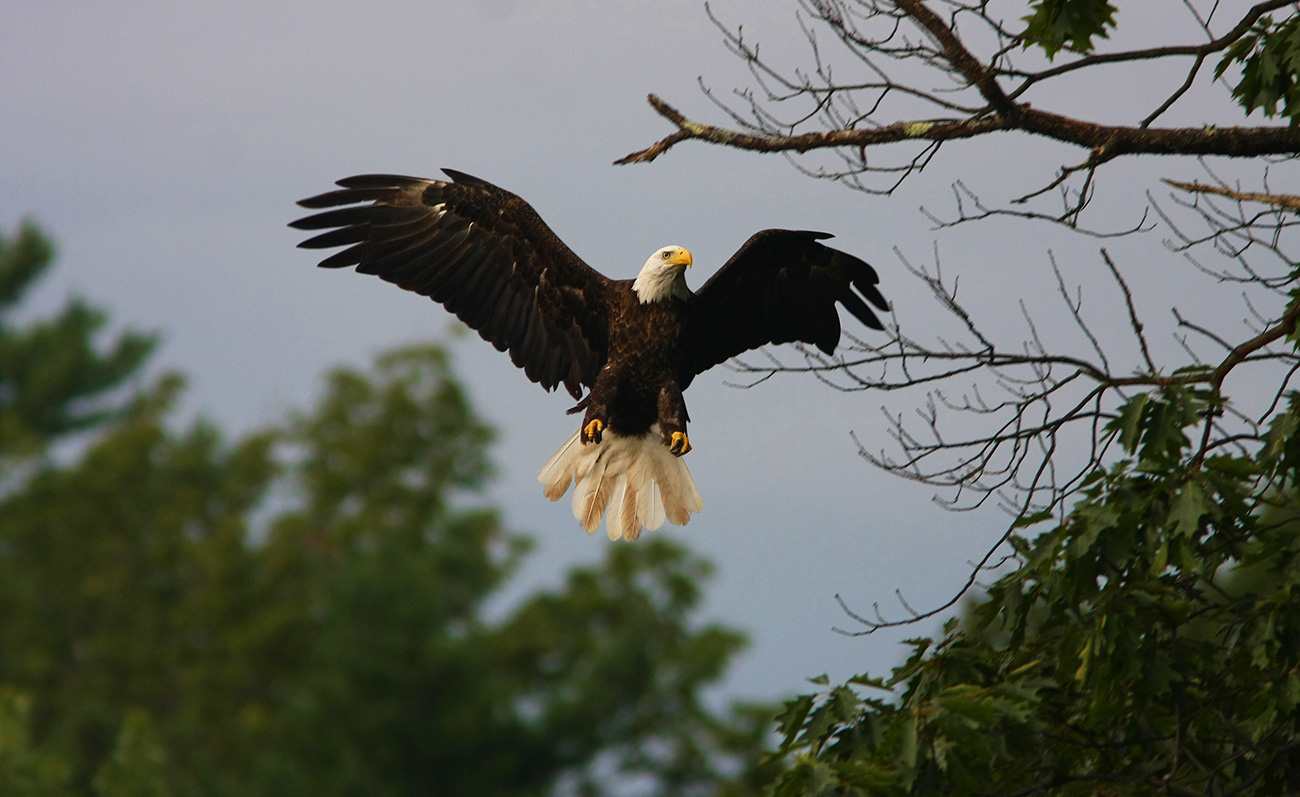Bald eagles are predominantly fish eaters, which is why they build their nests and live near water and why they migrate to open water areas like the Upper Delaware region in the winter. More than 100 eagles migrate to the Upper Delaware each winter in search of open water, fresh fish and undisturbed habitat.
The Delaware River valley offers important wintering habitat for a large population of bald eagles attracted to the open water for foraging. Depending on weather conditions, the eagles begin arriving in mid-December. By mid-March most eagles begin the return to their breeding areas located to the north. Some eagles migrate from as far away as Canada!
Golden eagles are less frequently sighted but are recorded nearly every winter. Until recently, your chances of actually seeing an eagle along the Upper Delaware were slim. That has changed, thanks to recent cooperative efforts to improve environmental conditions and to re-establish the bald eagle in the eastern United States.
Bald eagles are frequently seen along the river during the summer months and in 2002 the first recorded successful nest in the recreation area fledged two young.
Bald eagles are easily disturbed by human activity that alters their use of feeding and roosting areas. Please follow proper viewing etiquette and all posted regulations.
Eagle Etiquette
- Use binoculars instead of trying to “get a little closer.”
- Don’t try to make a bird fly, as it will waste precious energy which it needs to survive.
- Persons on foot are the most disturbing to bald eagles.
- Remember, it is illegal under federal and state laws to kill, trap, injure, take, annoy, harass, worry, or pursue (approach) a bald eagle. Up to $50,000 Fine and/or 1 Year Imprisonment for first offense.
For the least intrusive and most successful eagle viewing, please:
- Remain in your vehicle.
- Remain quiet. No loud music, yelling, door slamming, etc.
- Respect private property and restricted areas.
- Get out early in the day, between sun-up and 11 a.m., when eagles are most active.
- Bring binoculars or a good spotting scope (window mounts work great!)
- It’s almost impossible to get close enough for a good eagle picture with a point-and-shoot camera.
- For your safety:
- Pull completely off road when stopping; park in designated areas.
- Be prepared for ice, deep snow, or mud.
- Avoid hypothermia. Dress for extreme cold. Bring a hot drink!
- The key to successful viewing is patience!
The Delaware Highlands Conservancy leads guided eagle viewing trips to help you safely and considerately watch eagles in the Upper Delaware River watershed each winter.
Eagle Facts
Open Water
The primary food of wintering eagles is fish. Eagles typically perch on a branch extending over a body of water, and the branch is usually halfway between the surface of the water and the top of the tree. From these perches eagles swoop down toward their prey. Eagles have also been observed fishing on the wing and wading for fish. Favorite feeding areas include both shallow, fast rapids, and calm, shallow waters along river islands and sandbars.
Trees for Perches and Roosts
Eagles may spend up to 90% of their time in hunting perches and loafing perches. Typical perch trees are sycamore, white pine, and oak. Night roosts are sheltered areas where eagles gather to perch overnight. Bald eagles enter their breeding cycle while still in wintering grounds. Courtship and nest-building can begin at the end of February.
Protection From Human Disturbance
Eagles do not tolerate the presence of people well. Eagles will “flush” if approached within 1600 feet (1/3 mile.) If human activity continually flushes an eagle from its hunting and loafing perches, the eagle wastes energy on flight that is needed to maintain good physical condition, to survive the winter, and to successfully reproduce.
The Delaware Highlands Conservancy, which maintains a winter field office at the Zane Grey Museum in Lackawaxen, PA, offers year-round information on these majestic birds, as well as guided bus tours and wintertime updates on area viewing locations and eagle sightings, through its website at www.delawarehighlands.org/eagles, or call 570-226-3164 in PA and 845-583-1010 in NY.
